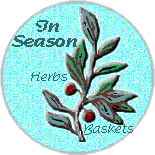
Winter | Spring | Summer | Fall | Holiday
Baskets | Community
Herbs and Baskets
winter
Here is a four-part project for a snowy day
- Add color to your yard by feeding the birds.
They have a hard time when all the food covered by ice or snow. - Add a mixed fruit cup loaded with Vitamin C to your menu. This requires adult supervision and participation.
- Use the orange peel to make candied peel. This requires adult supervision and participation.
- Plant the seeds you find when you make the fruit cup.
Materials and tools:
- oranges in a plastic net bag
- several grapefruit
- suet (beef or mutton fat)
- scissors
- string
- sugar
- a small saucepan
- a sharp knife
- some potting soil
- a container for planting
No waste from the bag of oranges and several short projects--what a deal!
Making the suet feeder
- Remove the oranges from the net bag.
- Use scissors to cut the bag crosswise into 2 or 3 smaller bands.
- Place suet inside each small band.
- Use string to tie one end shut close to the suet.
- Tie the other end
- Make a loop in the string to hand on a tree branch.
- Hang your suet bags in a tree.
Most birds will try suet. Here in North Carolina, our suet feeders have been visited by nuthatches, cardinals, woodpeckers, bluejays, flickers, and tufted titmouse, among others. Suet is a high-energy food for the birds.
Preparing the Fruit Cup, so many options
Freshly prepared sections of oranges and grapefruit with their juice is an easy and delicious addition to any meal.
Add banana slices, kiwi slices, grapes, or chopped apple to provide more color and variety. You have a healthy fruit salad.
Add fresh coconut and you have ambrosia.
Sprinkle the citrus sections with dried cranberries for a different winter treat.
To prepare grapefruit or orange sections
- Slice the ends off the fruit.
- Set the fruit on the now flat end.
- Take a sharp knife and cut diagonally out and then straight down, removing both the outer peel and the inner white peel. Slice slightly into the fruit so that you are also removing the membrane which holds the fruit in sections.
- Continue around the fruit, removing the peel in slices.
- The peeled fruit is now ready to section.
- Slice down each side of each membrane, freeing the sections.
- Remove any seed.
- Set the seed aside for planting.
- Squeeze the remnants to release any juice.
- Prepare your fruit cup.
- Add the membranes to your compost pile.
Candied Citrus Peel
Candying citrus is an old art. The candied peel is perfect for garnishing fruit salads and molds. It is refreshing in the spring and summer. Candied peel can also be used to decorate cakes. Some chocophiles like to dip candied citrus peel in chocolate.
- Use a sharp knife to remove the white inner peel from orange, grapefruit, lemon, and/or lime peels. Remove as much of the white peel as you can. The white inner peel is bitter.
- Cut the cleaned outer peel into strips.
- Put the strips of peel in a saucepan and cover with cold water. Bring to a boil and boil for 10-15 minutes. Drain. Repeat the boiling and draining 4-5 times. This removes bitterness from the peel. Add half of a cut lemon to each boiling, if you like. This seems to enhance the citrus flavor of the finished product, but it is not necessary.
- Make a syrup of 1 cup sugar and 1/2 cup water. Bring to a boil. Add the cooked and drained peel. Simmer until the syrup is absorbed and the peel is translucent. Be careful not to caramelize the sugar.
- Remove the candied peel from heat. Be careful. The peel is very hot.
- Use a fork to take the peel from the saucepan and drop in sugar. Roll the peel, a few strips at a time, in granulated sugar. Use your fork to separate the strips into individual pieces. Put the sugared strips on a rack or on waxed paper to dry.
- When dry, store in an airtight container. The strips can also be frozen.
Plant the Seed
Many kitchen trimmings can be "planted" to produce a new plant. Carrot tops and pineapple leaves will usually grow new foliage. The mature seed of citrus fruit will also sprout.
Fill a container with damp potting soil. Plant the citrus seeds about 1/2" deep in the soil. Keep the container watered and warm. In a few weeks, you should see a sprout, then leaves.
prev next
|
Site design, and webmastery by Cicada Consulting Group
Copyright © In Season Herbs and Basketsc 1997 All rights reserved. |
Page refreshed: Sat, Feb 23, 2002
http://www.inseason.com/winter/fourpartproject1.html |